
CHAPTER SIX
Playing Around:
Tutoring for Transfer in the Writing Center
TRANSFER OF LEARNING IN THE WRITING CENTER
Candace Hastings
Texas State University
As the director of the writing and speaking center at Texas A&M University, which has an enrollment of approximately 60,000 students, I find my mind is often on training our 55 peer consultants. Our consultants are undergraduate and graduate students, so we are in every sense of the word a peer tutoring center. One of our training requirements is that consultants complete a first-semester internship course that meets weekly for an hour. My first inclination, every fall, is to cram into that course everything about tutoring writing and speaking and the kitchen sink. We also hire students from various majors and programs, so I feel even more compelled to stuff the bus with foundational knowledge.
The beginning of the course focuses on the procedural knowledge new consultants need to conduct a session, such as how to begin and end a tutorial. We also introduce foundational writing center literature such as Stephen North's "The Idea of a Writing Center" and Kenneth Bruffee's "Peer Tutoring and the Conversation of Mankind." Because we tutor undergraduate and graduate writers in all disciplines, we discuss writing styles in multiple disciplines. And covering the basics of tutoring means the course syllabus seems to be organized around discrete tasks, such as how to tutor citation and documentation conventions. Considering all there is to learn about tutoring, breaking tutoring practices down into manageable parts makes sense.
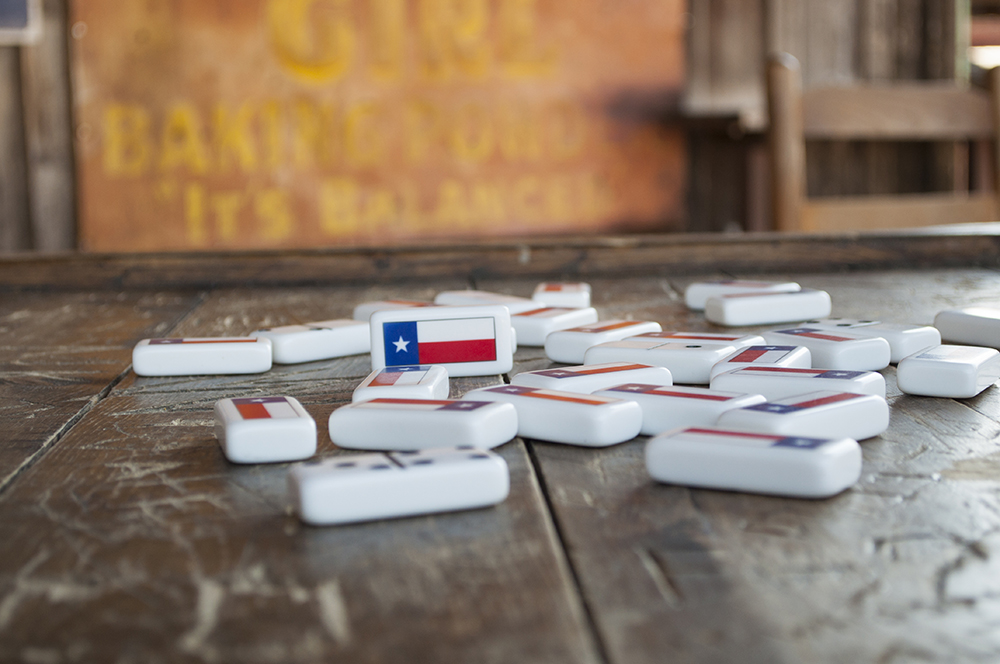 |
| Figure 1. Domino sets are often customized with family names, favorite sports teams, and of course, state flags. |
However, an unintended consequence of presenting tutoring materials or strategies in isolation is that the consultants themselves have no experience learning how to transfer their own skills. If consultants have not been exposed to learning transfer, it is unlikely that they can help writers learn to transfer knowledge from one context to another. Even if consultants work with writers multiple times throughout the drafting and revision process, pointing out patterns, consultants may still not know how to facilitate learning transfer. In "Tutoring for Transfer: The Benefits of Teaching Writing Center Tutors about Transfer Theory," Heather Hill argues for the inclusion of learning transfer theory in training, noting that the results of her study showed "the tutors who had been taught about transfer theory explicitly engaged their students in transfer talk considerably more than those who had not had that teaching" (85). Tutoring with learning transfer in mind is particularly important for our center because most undergraduates at Texas A&M "genre hop" between writing assignments for the first two years of their studies and then take writing-intensive courses as a requirement of Texas A&M University's writing in the disciplines (WID) program.
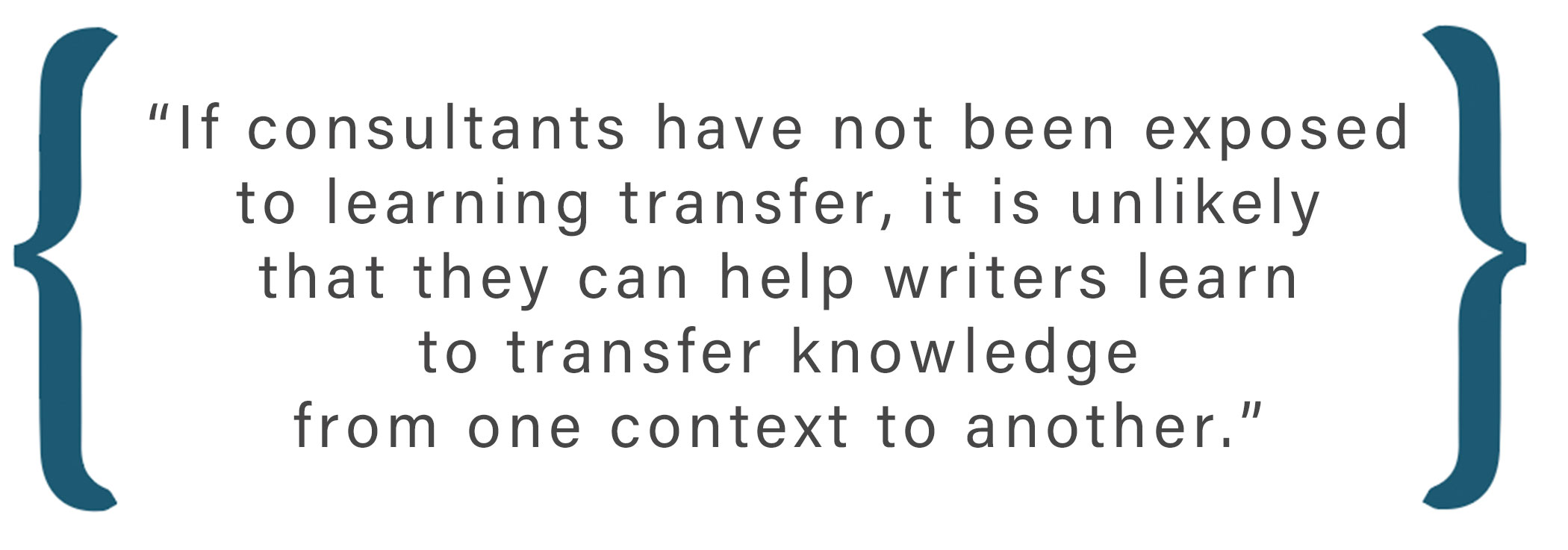 Yet, despite recent research on learning transfer in writing center contexts, learning transfer is often not included in consultant training curriculum. In "The Writing Center and Transfer of Learning: A Primer for Directors," Bonnie Devet observes her consultant "nurturing transfer" in a consultation by activating the student's prior knowledge about genre writing (140). Like Devet, I too have seen my consultants nurture transfer from time to time, but I wanted the process to be explicit, deliberate, and conscious. Therefore, I went about planning how I could incorporate learning transfer into my tutor training course.
Yet, despite recent research on learning transfer in writing center contexts, learning transfer is often not included in consultant training curriculum. In "The Writing Center and Transfer of Learning: A Primer for Directors," Bonnie Devet observes her consultant "nurturing transfer" in a consultation by activating the student's prior knowledge about genre writing (140). Like Devet, I too have seen my consultants nurture transfer from time to time, but I wanted the process to be explicit, deliberate, and conscious. Therefore, I went about planning how I could incorporate learning transfer into my tutor training course.
Perhaps it is time our North-facing writing centers broaden our mission from helping the writer to helping the learner—or helping the writer as learner. It was this idea I had in mind when I started teaching learning theory in my tutor–training internship courses. One theory I introduce early on is learning transfer: the good, the bad, and the ugly. In this chapter, to show how I incorporate the concept of transfer into the course, I briefly define learning transfer. Next, I describe the game I use in my training activity and how our consultants participate in and reflect on that game. Finally, I relate the consultants' actions and reflections back to relevant literature on learning transfer, including novice/expert learner characteristics, prior knowledge, low road/high road transfer, hugging, and cultural constructions of knowledge. This learning–by–doing approach, combined with reflection on incorporating theory into practice, provides a pedagogical strategy to teach consultants the importance of learning transfer in tutoring writing and speaking.
Training for Learning Transfer
Robert E. Haskell's work Transfer of Learning: Cognition, Instruction, and Reasoning defines transfer as "how previous learning influences current and future learning, and how past or current learning is applied or adapted to similar or novel situations" (23). Haskell discusses the complexities and difficulties of learning transfer and debunks the idea that learning transfer is a natural occurrence, even though transfer must happen for learning to occur. He emphasizes transfer is at the core of how learners learn and is not a teaching strategy. The essential question, then, is if learning transfer is an organic component of learning, can we teach our tutors to encourage transfer? Or more importantly, is it responsible to train consultants to tutor without incorporating learning transfer into our lessons since, according to Haskell, all learning requires some form of transfer?
As Haskell explains, transfer thinking begins with the instructors: "Before students can be expected or taught to transfer their learning, teachers also need to become proficient at transfer thinking" (42). Although much of the literature on transfer focuses on traditional classroom instruction, the literature is applicable to the writing center session as much as it is to the classroom. Writing center consultants need to understand transfer before any tutoring for transfer can occur, and I realized that I would need to be deliberate in training my consultants to tutor for transfer if I wanted it to happen.
Playing 42 to Teach Transfer
A few years ago, in my tutor-training course, I started facilitating activities that explore learning theory. In making the medium the message, I hoped my consultants would think metacognitively, becoming aware of their own thought processes, about some of the lessons learned from our games, which vary based on what aspect of learning we are studying. We solved problems and puzzles to study cognitive load (Willingham). We played memory games to learn about working memory and how much information a writer may be able to retain in a session. However, by far the most popular activity we did was to play the game "42," a domino game rooted in Texas culture, laden with possibilities of revealing through experience how learning transfer can work and how it often fails.
According to Dennis Roberson's article "Forty-Two" in the Texas Historical Society, the origins of the game 42 date back to the 1880s. For religious reasons, card games were forbidden in some Texas communities, so two boys invented a "card" game using dominoes instead of playing cards, calling the game "42." The game, according to Roberson, "quickly wove itself into the fabric of Texas communities and families and was passed down orally from generation to generation." It is still popular in Texas at family reunions and other gatherings. Texas Country Reporter, a statewide human interest show, shows how 42 is rooted in Texas culture and features Roberson as he attends the Texas State Championship 42 tournament.
| Figure 2. YouTube video entitled "42 Author (Texas Country Reporter)." https://www.youtube.com/watch?v=D-K5Z6JyX3Y&feature=emb_title. |
Because 42 has deep roots in Texas culture, many of our writing center consultants have heard of the game, but most do not have a working knowledge of how to play. I chose this particular game because it positions most of the consultants as novices, a role they are not used to in their writing center work. In addition, teaching and learning the game of 42 offers multiple opportunities for both successful and unsuccessful learning transfer.
 As I walk consultants through the rules of the game, I model learning transfer strategies to provide the catalyst for reflection on how they can use learning transfer in their writing center sessions. At the beginning of the activity, I ask consultants about their previous experience playing dominoes. Some respond they have played dominoes. However, that experience might not help the consultants, because most domino games rely on connecting dominoes, like a board game, which is very different from playing 42. Moreover, domino games are culturally and regionally rooted, so rules and practices vary by ethnicity and geographical location. I explain consultants will find few similarities between 42 and other domino games. If they have played bridge, hearts, or spades, I tell them 42 is similar, but played with dominoes instead of cards. I then explain the rules of 42, using the explanation, which I include in this chapter to provide context for the gaming activity and to show how difficult it is to learn a multi-step process by listening to instructions.
As I walk consultants through the rules of the game, I model learning transfer strategies to provide the catalyst for reflection on how they can use learning transfer in their writing center sessions. At the beginning of the activity, I ask consultants about their previous experience playing dominoes. Some respond they have played dominoes. However, that experience might not help the consultants, because most domino games rely on connecting dominoes, like a board game, which is very different from playing 42. Moreover, domino games are culturally and regionally rooted, so rules and practices vary by ethnicity and geographical location. I explain consultants will find few similarities between 42 and other domino games. If they have played bridge, hearts, or spades, I tell them 42 is similar, but played with dominoes instead of cards. I then explain the rules of 42, using the explanation, which I include in this chapter to provide context for the gaming activity and to show how difficult it is to learn a multi-step process by listening to instructions.
Explaining the Rules of 42
In this section, I will review the rules of 42 as I teach them to my consultants. In the game of 42, each domino has a pair of numbers on it (indicated by dots), from zero (blank) to six; a set of dominoes has 28 dominoes. Four players play in teams of two, who sit across from each other. At the beginning of the game, each of the four players draws seven dominoes from the pile of 28.
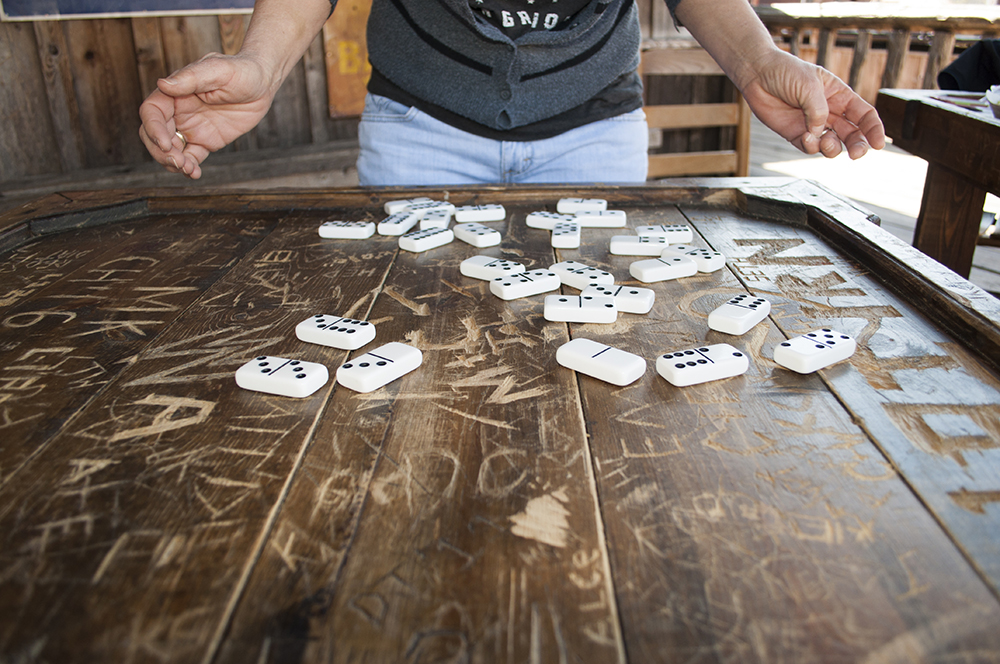 |
| Figure 3. Before play begins, all dominoes are placed face down in the center of a square table. The "shaker" shuffles the dominoes to ensure randomization. |
Players are not allowed to communicate with their teammates about the dominoes they have drawn. Each player bids individually, based on how many points they think the team can win. The minimum bid is 30 points, while the maximum bid is 42. Since each player has seven dominoes, seven "tricks" or "hands" are played in a game, and during play, one player wins each trick. Each trick won is worth one point; however, single dominoes that add up to 5 or 10 are worth 5 and 10 points, respectively, and are called "count" dominoes.
When a player wins a trick that contains a count domino, then the team gets one point for the hand plus the value of the count. The game's name reflects the total points played after seven tricks: 7 tricks + 35 total count dominoes = 42.
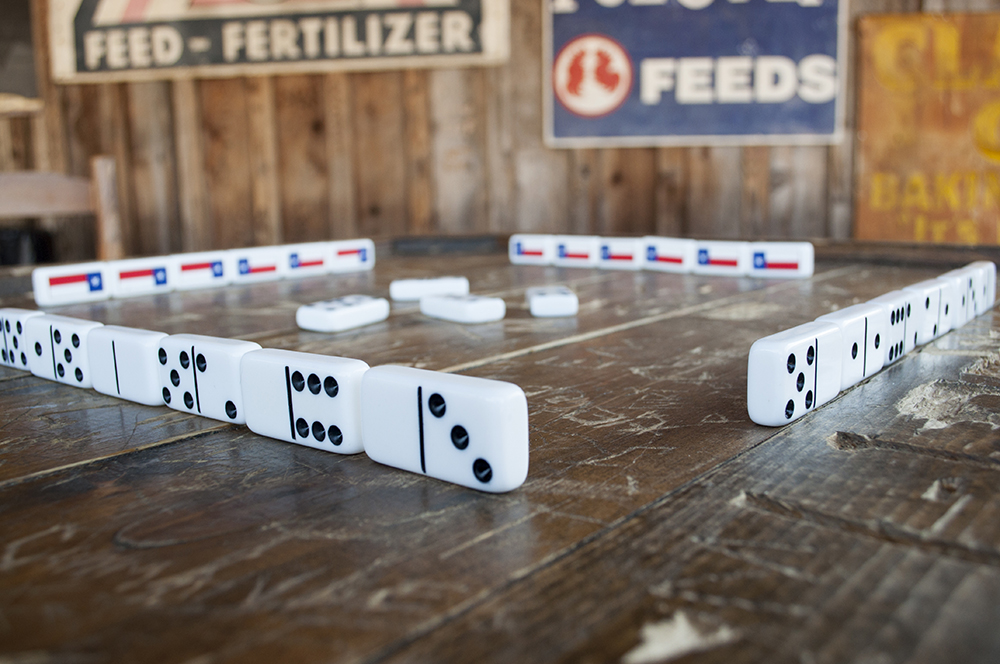 |
| Figure 4. Each player organizes their dominoes and lines them up sideways, hidden from the view of other players. |
The player with the highest bid picks a trump suit from the numbers on the dominoes—blanks, ones, twos, threes, fours, fives, or sixes—and starts by leading (playing a domino face up). Double numbers, such as five/five, are the highest domino in a suit, and numbers with blanks are the lowest (five/zero).
During play, each player matches the suit that has been led (played first). If a player does not have a domino of that suit, then any domino can be played. The highest domino in the suit wins the hand (trick), unless a trump is played. If a trump is played, then the highest trump domino wins the trick.
The winner of a trick takes the dominoes from the center and leads the next turn. After all seven tricks are played, the two teams combine their points for a final score. If the team that won the bid got at least the number of points they bid, that team wins a mark. If the opposing team prevented the bidding team from making their bid, then that team gets one mark. The dominoes are shuffled, and play starts again from the beginning. The first team to total seven marks wins the game.
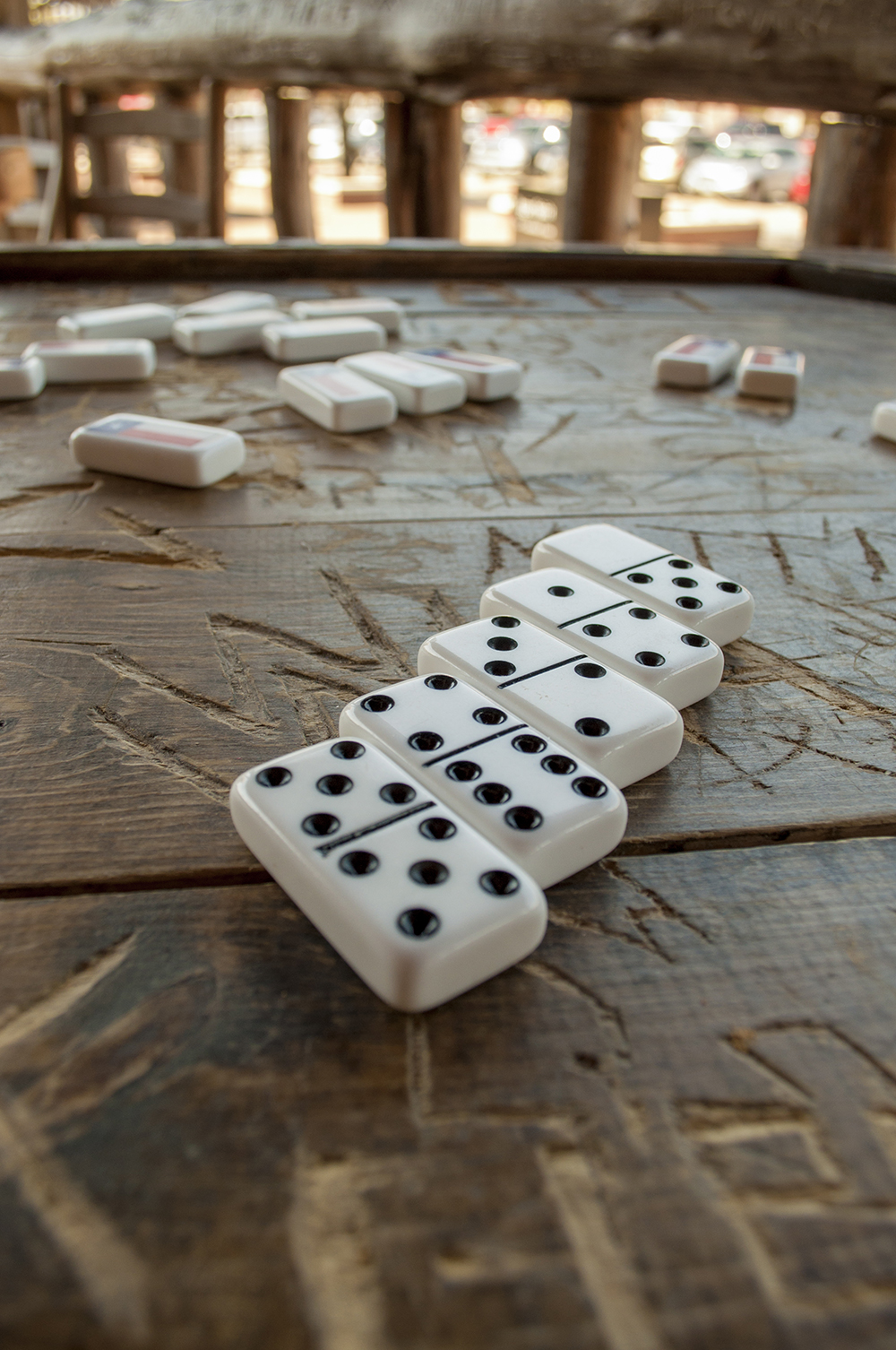 |
| Figure 5. Dominoes that add up to 5 or 10 are called "count" dominoes because they add either 5 or 10 points to the team's total at the end of each game. |
Playing 42
After explaining the rules of the game, I identify consultants who know how to play 42 and try to put at least one of those consultants at each four-person table as a peer mentor. Each table also has a reference sheet to use as a guide, including pictures of dominoes that show suits and count dominoes and their point values. The consultants start by playing two or three tricks with domino tiles facing up for practice.
The play goes slowly, with misplayed dominoes and group conversations about what domino to play, when, and why. Because the tricks are played hands-up, knowledge is socially constructed among the peer learners, with guidance from the peer mentors. During this time, I go around the room answering questions and monitoring play. After the practice rounds, the consultants play at least one trick with their domino tiles hidden from other players to test their knowledge. Playing the game takes about an hour from the time instructions are given to the last play. I then encourage the consultants to think metacognitively by reflecting on their learning experiences.
Lessons Learned and Consultant Reflections
After the game play is finished, the activity continues for another 15 minutes as consultants discuss how they felt as learners. Most consultants are lost by the end of my verbal instructions and have no idea how to start play, even with the reference sheet. Once play begins, consultants who are unfamiliar with 42 are not shy about expressing their frustration about not knowing what to do. Consultants who had played 42 or a similar game, however, expressed enthusiasm for how easy it was to learn and how much fun they had. We spend about 20 minutes talking about their different learning processes, and we talk about the learning theory that connects to those processes, including novice/expert learning and low road/high road transfer.
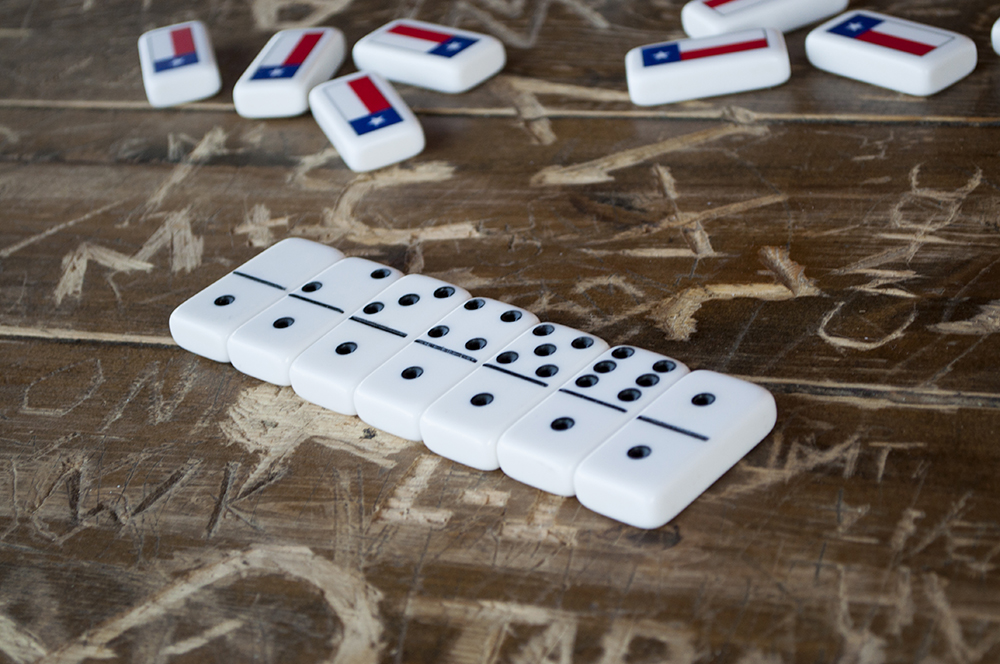 |
| Figure 6. The complete 1 suit is shown here, from the least valuable, the 1/0, to the most valuable, the double 1/1. Note that the 1/4 is a count domino and can add extra points to a team's total at the end of the game. |
Novice/Expert Learning Theory
At this point, to explain the differences between novice and expert learning, I use the Four Stages for Learning Any New Skill, first developed by Noel Burch from the Gordon Training Institute (GTI), reprised by Linda Adams in "Learning a New Skill is Easier Said Than Done," and often used by learning theory experts to explain how learners move from novices to experts. The first stage of learning is Unconsciously Unskilled (we don't know what we don't know nor do we know what we should know), the second is Consciously Unskilled (we know what we don't know), the third is Consciously Skilled (we know what we know, but it is not yet cognitive memory), and the fourth is Unconsciously Skilled (we know so much and it is so embedded in our cognitive memory that we are not conscious of what we know). When experts teach novices, they often make the erroneous assumption novices can retain information at the same rate as an expert. In the 42 activity, while the novices (Unconsciously or Consciously Unskilled) express frustration with not knowing how to play after rules are explained, consultants who know how to play 42 (the Consciously or Unconsciously Skilled) are easily able to follow my instructions.
As Susan Ambrose et al. explain in their own discussion of novice/expert learning, learners move from novice to expert by making connections between new and old information. Experts (skilled learners) connect discrete information into patterns of knowledge that help them apply what they know to prior knowledge and to different contexts (56). Skilled consultant players in the 42 activity recognize the links between 42 and spades, and they build connections based on prior knowledge that help them retain new information. To novice consultant players, every piece of information is discrete and disconnected. Ambrose et al. also note that processing completely disassociated information takes more time and increases cognitive load (99). As a result, novice players repeatedly make the same mistakes when trying to choose the best domino tile to play.
Novice/Expert Learning Reflection
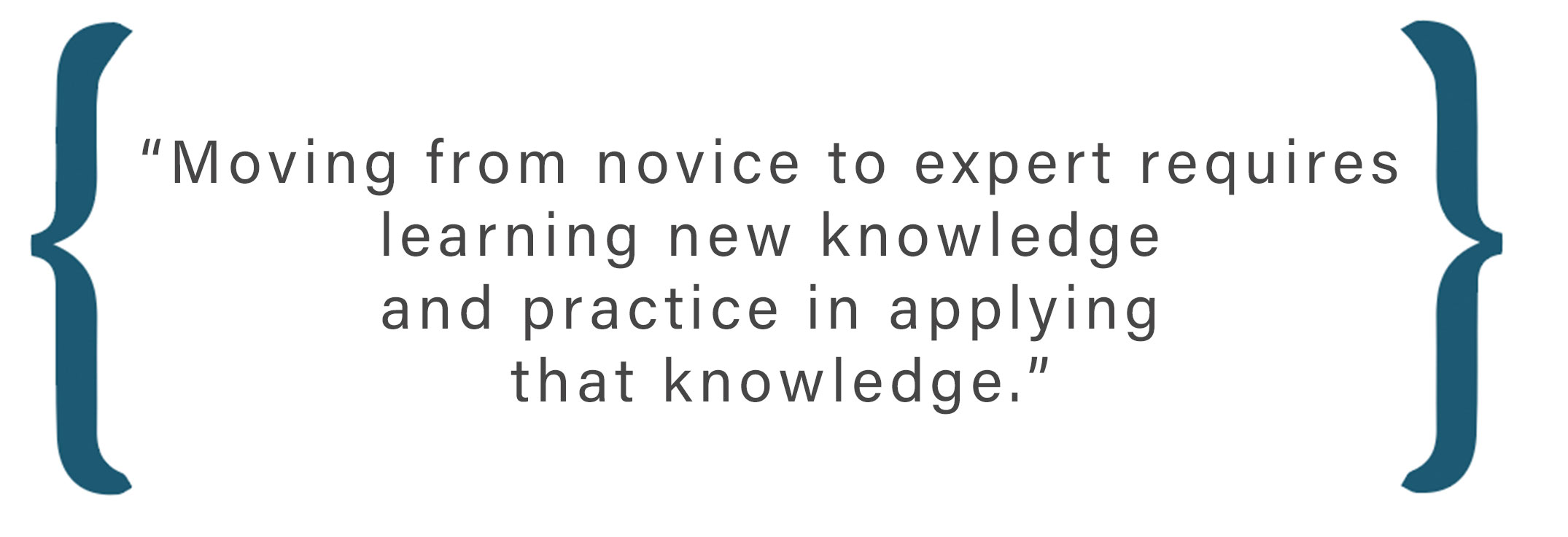 During reflection, I remind consultants that they become puzzled when working with writers who make the same mistakes over and over. I jokingly provoke them, asking them how they could make mistakes in playing the game when I tell them the rules ahead of time. This provocation often starts a conversation about strategies consultants could use to help novice writers remember new information without increasing cognitive load. The consultants suggest asking writers what they already know in order to understand how to activate prior knowledge and to apply learning from different contexts to help them move along the continuum from novice to expert. Consultants also advise alternating between providing information and asking writers to demonstrate that new knowledge by applying it to their texts. The consultants realize during the activity that more talking or more instruction in a session did not activate knowledge in a novice; rather, moving from novice to expert requires learning new knowledge and practice in applying that knowledge, which eventually reduces cognitive load, as Ambrose et al. note (105). In addition, Haskell asserts learners need practice to develop expertise in their area before they can transfer learning to other contexts (46).
During reflection, I remind consultants that they become puzzled when working with writers who make the same mistakes over and over. I jokingly provoke them, asking them how they could make mistakes in playing the game when I tell them the rules ahead of time. This provocation often starts a conversation about strategies consultants could use to help novice writers remember new information without increasing cognitive load. The consultants suggest asking writers what they already know in order to understand how to activate prior knowledge and to apply learning from different contexts to help them move along the continuum from novice to expert. Consultants also advise alternating between providing information and asking writers to demonstrate that new knowledge by applying it to their texts. The consultants realize during the activity that more talking or more instruction in a session did not activate knowledge in a novice; rather, moving from novice to expert requires learning new knowledge and practice in applying that knowledge, which eventually reduces cognitive load, as Ambrose et al. note (105). In addition, Haskell asserts learners need practice to develop expertise in their area before they can transfer learning to other contexts (46).
Some consultants were hesitant to make mistakes as they played, but they reflect that misplaying dominoes helped them learn. They talk about how high-stakes papers sometimes are stressful for their clients, but perhaps in writing center sessions, clients have the opportunity to learn from their mistakes. In discussing tutor development, Devet makes a similar point. She asserts "so-called 'perfect' consultations (assuming such sessions exist) are, ironically, less advantageous as models than imperfect ones because consultants miss an opportunity to see how to pick among options" (127).
Low Road and High Road Transfer Theory
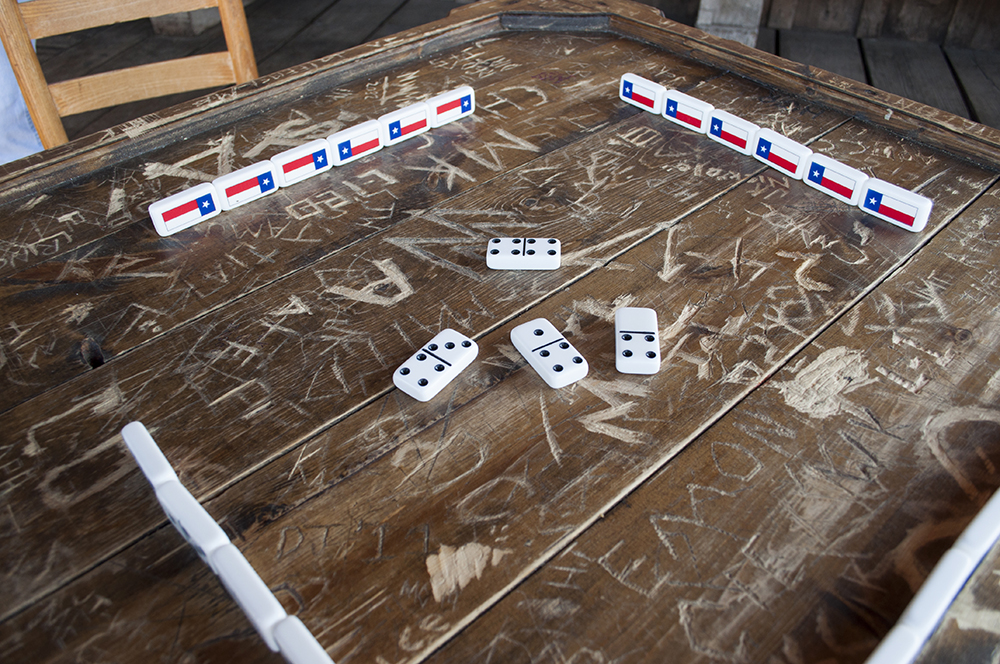 |
| Figure 7. In this hand, the double 4/4 would win the trick, and the team would also benefit from acquiring the 4/1 would add 5 points to the team's total points at the end of this round. |
Tutoring for transfer is still difficult for consultants to master, though. As Haskell explains, "learning isn't only welded to subject matter, but is often welded to the physical place where the learning occurred, and how it's encoded during the learning process" (47). Therefore, to tutor for learning transfer, consultants need to know how to break the weld that holds knowledge to one physical place or context. To address this challenge, David N. Perkins and Gavriel Salomon's model of transfer emphasizes that "knowledge (including skill) tends to be local rather than general" (24).
Perkins and Salomon explain that there are low road (near) transfers and high road (far) learning transfers. A low road transfer happens when contextual similarities provide cues to learning the new information, and "transfer occurs because there is considerable overlap" (24). For example, in the 42 activity, consultants who know how to play a card game that includes bidding and trumps can use low road transfer to make necessary connections between the rules of the card game and the new game, 42. On the other hand, Perkins and Salomon define "high road transfer" as transfer that occurs in situations with little overlap between two contexts (26). In this scenario, learners must reflect on what connections might exist between contexts. For example, a highly experienced 42 player might use their expertise in anticipating an opponent's play, based on the opponent's bidding practices to negotiating a real estate deal. High road transfer is elusive, requiring a level of expertise on the part of the learner, so most of my training focuses on low road transfer strategies. However, experienced writers do use high road transfer as they make connections between writing and seemingly disparate things using similes and analogies, as exemplified in the following well-known quote in the Paris Review from E.L. Doctorow: "Writing is like driving at night in the fog. You can only see as far as your headlights, but you can make the whole trip that way" (Plimpton).
Low Road and High Road Transfer Reflection
After the 42 activity, we talk about tutoring strategies consultants can use with their writers to facilitate low road transfer. One approach is "hugging," or making explicit connections between learning situations (Perkins and Salomon 24). For example, I use hugging when I announce that 42 is essentially a card game played with dominoes. The more explicit and detailed the hugging, the better the opportunities for transfer. I also tell consultants that, like bridge, hearts, or spades, 42 is a partner game using bidding, where high trumps take tricks, and so on. In our discussion, we talk about how sometimes those analogies break down. Ambrose et al. emphasize explaining where analogies fall short (22). For example, in the game of spades, the spades suit is always the trump. However, in 42, the highest bidder has the choice of trump. In addition, cards have both numbers and suits (hearts, diamonds, spades, and clubs). In 42, the domino numbers are themselves the suits. This concept can confuse consultants who try to wholesale analogize between the two games, which is a nice demonstration of how learners can take analogies too far.
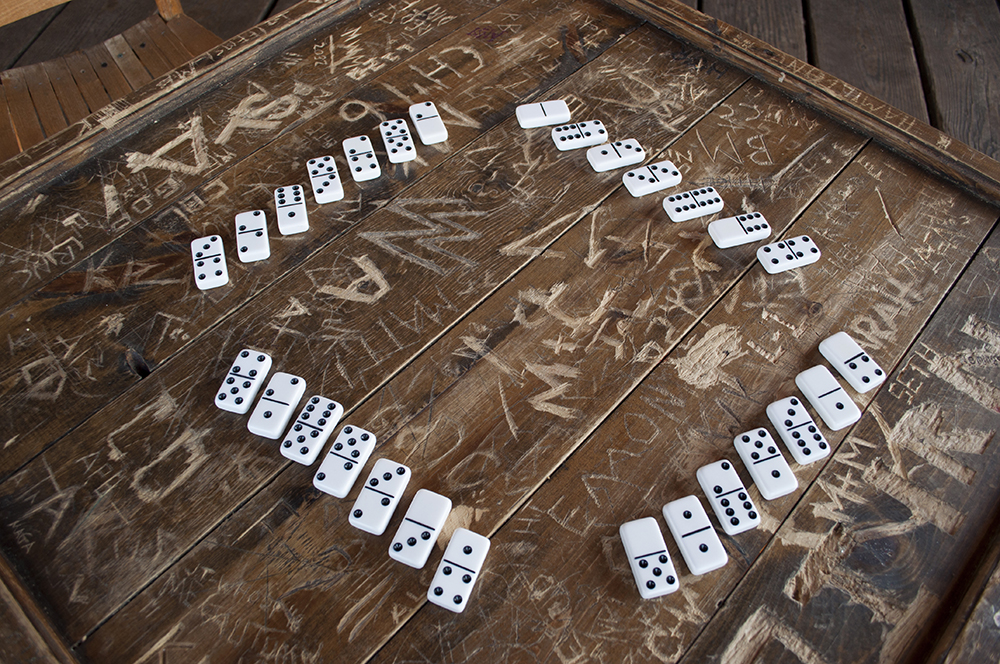 |
| Figure 8. When I use the game of 42 to teach transfer theory, I always start with having tutors playing at least 3 or 4 hands "face-up." The tutors are then able to co-construct knowledge about rules and strategies. |
Being explicit about beginning with a learner's prior knowledge and drawing close analogies help the learner move away from misconceptions (Ambrose et al. 26.). After discussing their own learning experiences in the game, consultants reflect on how they can help writers by using hugging strategies, and they discuss the importance of being explicit in explaining overlap between closely related concepts in low road transfer. For instance, a consultant can use hugging to help a writer transition to a new citation style by explicitly pointing out the similarities and differences between the two styles. In addition, we discuss the importance of finding out what the writer already knows, since low road transfer depends on the level of a learner's expertise. Haskell notes a learner's "knowledge base greatly influences whether something is considered near or far transfer" (30). Therefore, if a writer needs to transition to a new citation style but does not understand the more familiar one, then hugging would not be an effective learning transfer strategy. Far transfer or high road transfer is a much more difficult task. If consultants have expertise with a different domino game, such as Chicken Foot, transfer is more difficult than it would be if they had no prior knowledge of dominoes at all, since the only similarity between the games is the domino tiles themselves.
In addition, because knowledge is socially constructed, the various games played with dominoes are often historically connected to family and culture. Those with cultural attachments to different domino games sometimes resist learning a "new" game that may supplant their value-laden memories. To exemplify how value-laden knowledge can be, I tell my consultants a story about a time I used the 42 activity in a graduate-level college teaching class. One semester during the activity, a student became very upset and refused to participate. She made clear that she knew how to play dominoes, that, in fact, she was an expert at a domino game called "bones" and did not consider 42 to be a legitimate domino game worth learning. In fact, the next week in class, she brought me her personal set of dominoes engraved with her family name to prove the legitimacy of her claim as an expert. During that next class, she told the class about the game bones and how it was rooted in her family history, as she passed around her engraved dominoes for the class to see.
Many consultants relate my graduate student's experience to writers who bring their own languages, dialects, and styles of writing to the rigidity and socially constructed gatekeeping practices of academic writing. In their theory of legitimate peripheral participation, Jean Lave and Etienne Wenger focus on the dynamic nature of communities of practice and the adherence to practices that legitimize or de-legitimize membership in a particular community. In applying legitimate peripheral participation to academic writing, language and written expression are gatekeepers, excluding some writers but admitting others, based on the language each brings to the table. As Harry Denny reminds us, "We need to think through and develop strategies, always in collaboration with students, that attend to the literacies they need or offer us for growth" (86). In our group reflection, consultants discuss ways to celebrate language diversity and dispel notions that different is deficit. I am honest in telling my consultants that I was ill-equipped to handle my student's discomfort with the 42 activity at first because I was blind to the cultural construction of the game.
Instilling the Spirit of Transfer
Haskell argues that for transfer to occur there needs to be a "spirit of transfer," that learners must be motivated to transfer and experts should nurture that spirit (117). Indeed, the spirit of transfer is an attitude, a way of thinking about learning and knowledge, calling on learners to think about and practice transfer. Exploring the cultivation of this spirit of transfer in writing instruction and writing center contexts, Kathleen Blake Yancey et al. suggest helping students think like writers through deep reflection by comparing writing genres or by developing theories or frameworks of writing (4). To this end, in "'Mutt Genres' and the Goal of FYC: Can We Help Students Write the Genres of the University?," Elizabeth Wardle even proposes first-year students take a course on writing about writing, where the "content will also teach general principles about writing—the very principles that novices need—but without framing them as decontextualized 'skills' that might become confusing to students when they are faced with a new writing situation" (785). It is this spirit of transfer that I hope to bring to our center's training.
One way consultants can play a pivotal role in promoting a spirit of transfer is by helping writers develop their own writing vocabulary, as Yancey et al. advocate (135). In our writing center entry survey, we ask writers what they want help with, and most choose "grammar," likely because they do not have a writing vocabulary. In the 42 activity, learners with operational knowledge of the vocabulary used in games similar to 42 such as "trump" and "lead" are able to low road transfer their knowledge. Consultants, too, can be pivotal in helping writers develop the vocabulary they need as writers to transfer their learning from one context or genre to another.
Creating a Transferable Center
 At times, it is difficult to provide all the training consultants need. Teaching or tutoring for transfer adds a layer of complexity to training that might not seem worth the time, considering how learning transfer has many more ways to fail than to succeed. However, negating the importance of introducing transfer in our training classes increases the chance writers will return to the center as blank slates each time, as when Bill Murray relives the same day over and over again in the movie Groundhog Day.
At times, it is difficult to provide all the training consultants need. Teaching or tutoring for transfer adds a layer of complexity to training that might not seem worth the time, considering how learning transfer has many more ways to fail than to succeed. However, negating the importance of introducing transfer in our training classes increases the chance writers will return to the center as blank slates each time, as when Bill Murray relives the same day over and over again in the movie Groundhog Day.
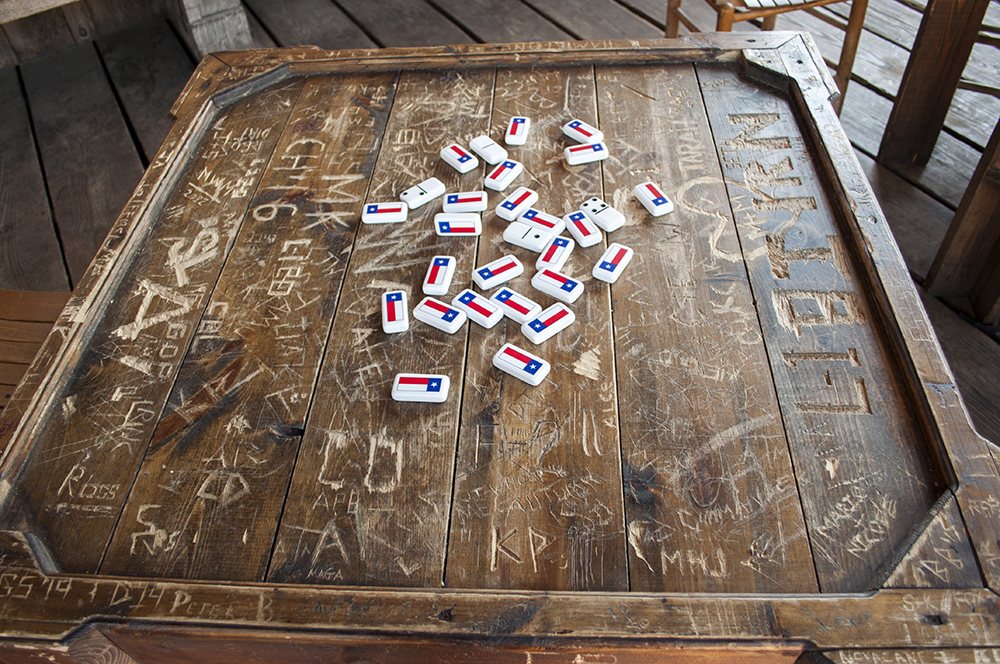 |
| Figure 9. The game of 42 has been a useful way for me to teach learning transfer, but any game that allows for co-creation of knowledge, learning transfer principles, and expert–novice engagement can provide an experiential learning opportunity for tutors. |
Transfer has to occur for learning to happen but expecting it to happen without being intentional or explicit is playing long odds, as Haskell notes. Games are a great way to get consultants thinking like learners and to help them learn to practice transfer. Of course, a successful lesson on learning transfer does not mean having to play 42. The training activity could be a game or a puzzle. To be effective, though, the activity needs to position consultants as novice participants, provide opportunities for low road transfer, and include reflective discussion.
By embedding a spirit of transfer into tutor training, directors can extend a consultant's ability to help writers in broad, effective ways. "Nurturing transfer," to use Devet's phrase, is essential for broadening our mission to help writers as learners, particularly in the realm of learning transfer. I have found the effort to be worthwhile, at least to play around with.
Works Cited
Ambrose, Susan A., et al. How Learning Works: 7 Research-Based Principles for Smart Teaching. Jossey-Bass, 2010.
Adams, Linda. "Learning a New Skill is Easier Said Than Done." Gordon Training International, 2016.
Bruffee, Kenneth. "Peer Tutoring and the Conversation of Mankind." Landmark Essays on Writing Centers, vol. 9, edited by Christina Murphy, Hermagoras Press, 1995.
Denny, Harry. Introduction to "Multiliteracies, Social Futures, and Writing Centers." The Writing Center Journal, vol. 30, no. 1, Spring 2010, pp. 84-87.
Devet, Bonnie. "The Writing Center and Transfer of Learning: A Primer for Directors." The Writing Center Journal, vol. 35, no. 1, Fall/Winter 2015, pp. 119-51.
Haskell, Robert E. Transfer of Learning: Cognition, Instruction, and Reasoning. Academic Press, 2001.
Hill, Heather N. "Tutoring for Transfer: The Benefits of Teaching Writing Center Tutors about Transfer Theory." The Writing Center Journal, vol. 35, no. 3, Spring 2016, pp. 77-102.
Lave, Jean, and Etienne Wenger. Situated learning: Legitimate Peripheral Participation. Cambridge UP, 1991.
North, Stephen. "The Idea of a Writing Center." College English, vol. 46, no. 5, September 1984, pp. 433-46.
Perkins, David N., and Gavriel Salomon. "Teaching for Transfer." Educational Leadership, vol. 46, no. 1, September 1988, pp. 22-32.
Plimpton, George. "E. L. Doctorow, The Art of Fiction No. 94." The Paris Review, Issue 101, Winter 1986, https://www.theparisreview.org/interviews/2718/e-l-doctorow-the-art-of-fiction-no-94-e-l-doctorow.
Ramis, Harold, director. Groundhog Day. Columbia Pictures, 1993.
Roberson, Dennis. "Forty-Two (Domino Game)." Texas State Historical Society, 12 June 2010.
Texas Country Reporter. "42 Author." YouTube, 15 Jan. 2014, https://www.youtube.com/watch?v=D-K5Z6JyX3Y&feature=emb_title.
Wardle, Elizabeth. "'Mutt Genres' and the Goal of FYC: Can We Help Students Write the Genres of the University?" College Composition and Communication, vol. 60, no. 4, June 2009, pp. 765-89.
Willingham, Daniel. Why Don't Students Like School? A Cognitive Scientist Answers Questions About How the Mind Works and What It Means for the Classroom. Jossey-Bass, 2009.
Yancey, Kathleen Blake, et al. Writing Across Contexts: Transfer, Composition, and Sites of Writing. Utah State UP, 2014.
BIO
Candace Hastings is the Director of Faculty Development at Texas State University. Formerly, she was the Director of the University Writing Center at Texas A&M University. Her research interests focus on teaching and learning, faculty development, and academic integrity. You can contact her at hastings@txstate.edu.